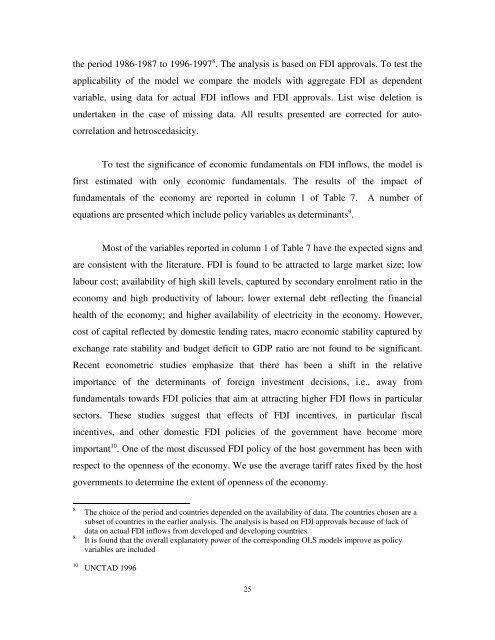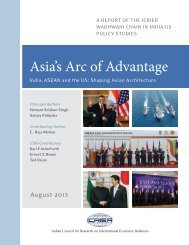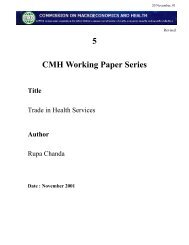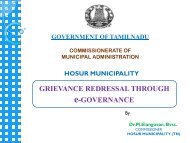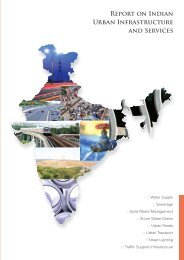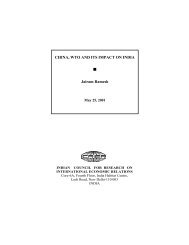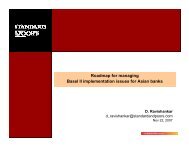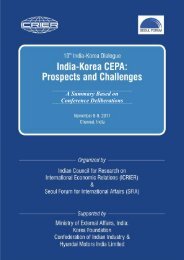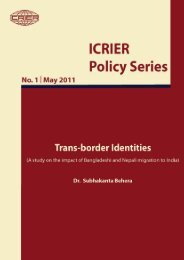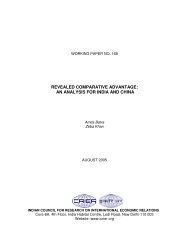impact of government policies and investment agreements on fdi ...
impact of government policies and investment agreements on fdi ...
impact of government policies and investment agreements on fdi ...
You also want an ePaper? Increase the reach of your titles
YUMPU automatically turns print PDFs into web optimized ePapers that Google loves.
the period 1986-1987 to 1996-1997 8 . The analysis is based <strong>on</strong> FDI approvals. To test the<br />
applicability <str<strong>on</strong>g>of</str<strong>on</strong>g> the model we compare the models with aggregate FDI as dependent<br />
variable, using data for actual FDI inflows <str<strong>on</strong>g>and</str<strong>on</strong>g> FDI approvals. List wise deleti<strong>on</strong> is<br />
undertaken in the case <str<strong>on</strong>g>of</str<strong>on</strong>g> missing data. All results presented are corrected for autocorrelati<strong>on</strong><br />
<str<strong>on</strong>g>and</str<strong>on</strong>g> hetroscedasicity.<br />
To test the significance <str<strong>on</strong>g>of</str<strong>on</strong>g> ec<strong>on</strong>omic fundamentals <strong>on</strong> FDI inflows, the model is<br />
first estimated with <strong>on</strong>ly ec<strong>on</strong>omic fundamentals. The results <str<strong>on</strong>g>of</str<strong>on</strong>g> the <str<strong>on</strong>g>impact</str<strong>on</strong>g> <str<strong>on</strong>g>of</str<strong>on</strong>g><br />
fundamentals <str<strong>on</strong>g>of</str<strong>on</strong>g> the ec<strong>on</strong>omy are reported in column 1 <str<strong>on</strong>g>of</str<strong>on</strong>g> Table 7. A number <str<strong>on</strong>g>of</str<strong>on</strong>g><br />
equati<strong>on</strong>s are presented which include policy variables as determinants 9 .<br />
Most <str<strong>on</strong>g>of</str<strong>on</strong>g> the variables reported in column 1 <str<strong>on</strong>g>of</str<strong>on</strong>g> Table 7 have the expected signs <str<strong>on</strong>g>and</str<strong>on</strong>g><br />
are c<strong>on</strong>sistent with the literature. FDI is found to be attracted to large market size; low<br />
labour cost; availability <str<strong>on</strong>g>of</str<strong>on</strong>g> high skill levels, captured by sec<strong>on</strong>dary enrolment ratio in the<br />
ec<strong>on</strong>omy <str<strong>on</strong>g>and</str<strong>on</strong>g> high productivity <str<strong>on</strong>g>of</str<strong>on</strong>g> labour; lower external debt reflecting the financial<br />
health <str<strong>on</strong>g>of</str<strong>on</strong>g> the ec<strong>on</strong>omy; <str<strong>on</strong>g>and</str<strong>on</strong>g> higher availability <str<strong>on</strong>g>of</str<strong>on</strong>g> electricity in the ec<strong>on</strong>omy. However,<br />
cost <str<strong>on</strong>g>of</str<strong>on</strong>g> capital reflected by domestic lending rates, macro ec<strong>on</strong>omic stability captured by<br />
exchange rate stability <str<strong>on</strong>g>and</str<strong>on</strong>g> budget deficit to GDP ratio are not found to be significant.<br />
Recent ec<strong>on</strong>ometric studies emphasize that there has been a shift in the relative<br />
importance <str<strong>on</strong>g>of</str<strong>on</strong>g> the determinants <str<strong>on</strong>g>of</str<strong>on</strong>g> foreign <str<strong>on</strong>g>investment</str<strong>on</strong>g> decisi<strong>on</strong>s, i.e., away from<br />
fundamentals towards FDI <str<strong>on</strong>g>policies</str<strong>on</strong>g> that aim at attracting higher FDI flows in particular<br />
sectors. These studies suggest that effects <str<strong>on</strong>g>of</str<strong>on</strong>g> FDI incentives, in particular fiscal<br />
incentives, <str<strong>on</strong>g>and</str<strong>on</strong>g> other domestic FDI <str<strong>on</strong>g>policies</str<strong>on</strong>g> <str<strong>on</strong>g>of</str<strong>on</strong>g> the <str<strong>on</strong>g>government</str<strong>on</strong>g> have become more<br />
important 10 . One <str<strong>on</strong>g>of</str<strong>on</strong>g> the most discussed FDI policy <str<strong>on</strong>g>of</str<strong>on</strong>g> the host <str<strong>on</strong>g>government</str<strong>on</strong>g> has been with<br />
respect to the openness <str<strong>on</strong>g>of</str<strong>on</strong>g> the ec<strong>on</strong>omy. We use the average tariff rates fixed by the host<br />
<str<strong>on</strong>g>government</str<strong>on</strong>g>s to determine the extent <str<strong>on</strong>g>of</str<strong>on</strong>g> openness <str<strong>on</strong>g>of</str<strong>on</strong>g> the ec<strong>on</strong>omy.<br />
8<br />
8<br />
10<br />
The choice <str<strong>on</strong>g>of</str<strong>on</strong>g> the period <str<strong>on</strong>g>and</str<strong>on</strong>g> countries depended <strong>on</strong> the availability <str<strong>on</strong>g>of</str<strong>on</strong>g> data. The countries chosen are a<br />
subset <str<strong>on</strong>g>of</str<strong>on</strong>g> countries in the earlier analysis. The analysis is based <strong>on</strong> FDI approvals because <str<strong>on</strong>g>of</str<strong>on</strong>g> lack <str<strong>on</strong>g>of</str<strong>on</strong>g><br />
data <strong>on</strong> actual FDI inflows from developed <str<strong>on</strong>g>and</str<strong>on</strong>g> developing countries.<br />
It is found that the overall explanatory power <str<strong>on</strong>g>of</str<strong>on</strong>g> the corresp<strong>on</strong>ding OLS models improve as policy<br />
variables are included<br />
UNCTAD 1996<br />
25


